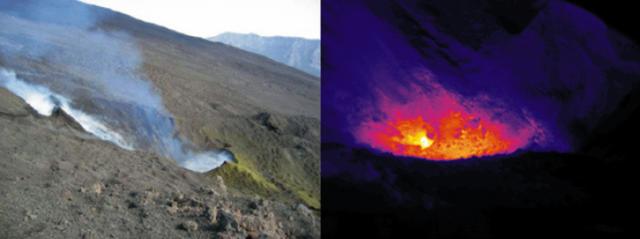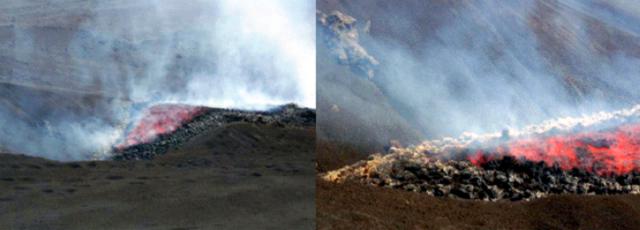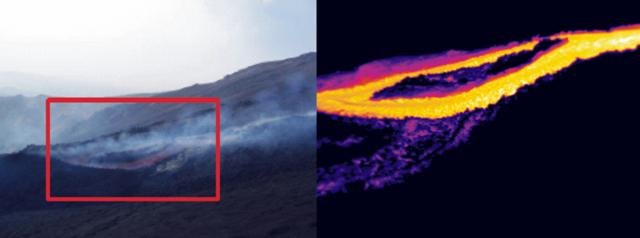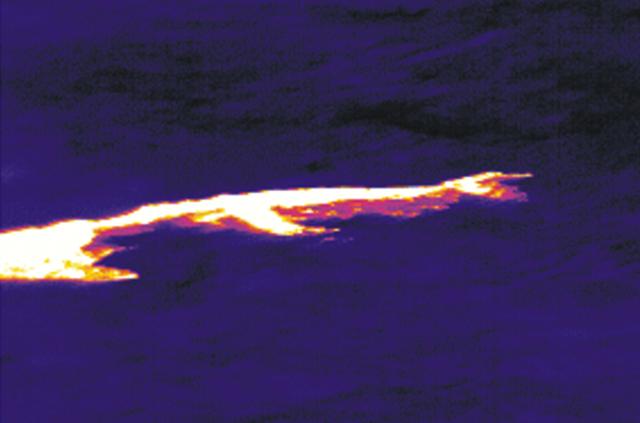Report on Etna (Italy) — September 2004
Bulletin of the Global Volcanism Network, vol. 29, no. 9 (September 2004)
Managing Editor: Richard Wunderman.
Etna (Italy) New effusive eruption begins on 7 September and spreads to several fissure vents
Please cite this report as:
Global Volcanism Program, 2004. Report on Etna (Italy) (Wunderman, R., ed.). Bulletin of the Global Volcanism Network, 29:9. Smithsonian Institution. https://doi.org/10.5479/si.GVP.BGVN200409-211060
Etna
Italy
37.748°N, 14.999°E; summit elev. 3357 m
All times are local (unless otherwise noted)
At about 1030 on 7 September 2004 a new effusive eruption started from the summit of Mount Etna. A N110°E-trending eruptive fissure about 230 m long opened at the base of the SE Crater without any significant seismic activity. A degassed lava flow poured from the base of the fissure, spreading towards the Valle del Bove. The lava flow had very low output rate (between 0.2 and 0.5 m3/s), and was ~ 1 m thick, 10 m wide, and up to 250 m long. On the morning of 8 September the lava flow appeared to lack new input from its source, but the eruptive fissure continued to advance down slope. These events were not accompanied by seismicity or explosive activity.
After two days of slow expansion of the fracture field, a new effusive vent opened at a lower elevation, 2,650 m, on the upper western flank of the Valle del Bove. This occurred between 0600 and 0700 on 10 September. Lava poured from this vent, spreading over the upper wall of the Valle del Bove. No explosive activity accompanied the emission of lava, but some phreatic explosions were triggered by lava intersecting a thick cover of snow. The lava flow was degassed and flowed out at a rate of about 2-4 m3/s. It spread E to the Serra Giannicola Piccola before splitting in two branches. At about 0930 the longest branch was about 300 m long and 50 m wide. Due to the high slope-angle, the front of the N lava flow breached. Hot blocks rolled down slope, causing the flow front to expand due to the collapse of hot debris rather than by flowage. At 1400 the lowest elevation of the lava flow front was about 2,250 m elevation within the upper Valle del Bove. At that time, no villages were threatened by the lava flows since they had spread out over a deserted zone at least 10 km away from the nearest village.
Activity appeared similar on 14-15 September 2004, when Mike Burton, Enza Longo, and Margherita Polacci had clear views of the Valle Del Bove in fair weather. Their first observations were carried out at the Southeast Crater (SEC), where the team saw a conspicuous plume emitted from a fumarole field on the SEC's SE rim. This activity, not seen prior to the eruption, had been consistently observed during the previous 3-4 days.
A visit to a vent at 2,830 m elevation revealed behavior similar to previous days, consisting of continuous high-pressure degassing in the absence of explosive activity (figure 104). At this vent, in contrast to the one at 2,630 m (which emitted lava), incandescence was limited to a circular zone at the vent area. No recent scoria were observed near the degassing vent. At this degassing vent the peak temperature, measured with a thermal camera, was ~ 900°C (see thermal image, figure 8).
 |
Figure 104. A vent emitting high-pressure gas at 2,830 m on Etna, 15 September 2004, with thermal image of the vent's mouth (at right). Courtesy of Mike Burton, Enza Longo, and Margherita Polacci. |
The team also visited the lava flow at 2,630 m (figure 105). Fresh scoria had fallen along the path leading to the lava flow, and samples were collected. The estimated flux rate of the lava flow was between 2 and 4 m3/s, using an estimated flow velocity of 1 m/s, a width of 2 m, and a depth of 1-2 m. Estimates were obtained by observing the lava flow just above the rock island seen in figure 9. This flux was roughly equal to that seen on 13 September.
A pair of hornitos lay up slope of the lava flow originating at 2,630 m elevation. One hornito sat just behind the spot where lava was first observed on the surface. The second hornito was larger and resided about 20-30 m farther up slope (figure 106). It released gas at high pressure, creating noise. No scoria were emitted during their observation.
Polacci and Burton then walked down to the lava flow that began on 13 September (figure 107). The lava flow's flux rate was low. The team estimated an outflow rate of ~ 1 m3/s, using a width of 2 m, a flow velocity of 0.5 m/s, and a depth of 1 m, dimensions noted near the lava flow's source. The lava flow emanated from a small depression; no scoria deposits were seen nearby. GPS established the flow's source at 2,340 m elevation. The team observed several distinct overflows escaping from the principal lava flow, which originated at 2,630 m elevation (figure 108).
 |
Figure 107. The source of an Etna lava flow at 2,340 m elevation, as seen in two photographs taken on 14 or 15 September. Courtesy of Mike Burton, Enza Longo, and Margherita Polacci. |
Geological Summary. Mount Etna, towering above Catania on the island of Sicily, has one of the world's longest documented records of volcanism, dating back to 1500 BCE. Historical lava flows of basaltic composition cover much of the surface of this massive volcano, whose edifice is the highest and most voluminous in Italy. The Mongibello stratovolcano, truncated by several small calderas, was constructed during the late Pleistocene and Holocene over an older shield volcano. The most prominent morphological feature of Etna is the Valle del Bove, a 5 x 10 km caldera open to the east. Two styles of eruptive activity typically occur, sometimes simultaneously. Persistent explosive eruptions, sometimes with minor lava emissions, take place from one or more summit craters. Flank vents, typically with higher effusion rates, are less frequently active and originate from fissures that open progressively downward from near the summit (usually accompanied by Strombolian eruptions at the upper end). Cinder cones are commonly constructed over the vents of lower-flank lava flows. Lava flows extend to the foot of the volcano on all sides and have reached the sea over a broad area on the SE flank.
Information Contacts: Sonia Calvari, Mike Burton, Enza Longo, and Margherita Polacci, Istituto Nazionale di Geofisica e Vulcanologia (INGV), Piazza Roma 2, 95123 Catania, Italy.




